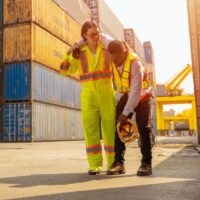What Is the Difference Between Slip and Fall and Trip and Fall?

Accidents resulting in personal injuries are unfortunately common, especially in bustling cities like Philadelphia. Among these incidents, slip and fall and trip and fall accidents are particularly prevalent. Although these terms are often used interchangeably, they describe different types of accidents with distinct causes and implications. Understanding the difference between slip and fall and trip and fall accidents can be crucial for injury victims seeking compensation. Read on to learn more about the important distinctions between these two types of accidents. If you have been injured in a slip and fall or trip and fall on someone’s dangerous premises in Philadelphia, contact Benedum Law to speak with an experienced and successful Chestnut Hill personal injury lawyer.
Slip and Fall Accidents
A slip and fall accident occurs when a person loses their footing due to a lack of traction between their shoe and the walking surface. This can happen on any type of surface but is most common on slick or slippery floors. Common causes of slip and fall accidents include:
- Wet or freshly waxed floors
- Spills of liquids or food
- Ice, snow, or rain accumulation on walkways
- Loose rugs or mats
- Smooth or polished flooring without adequate grip
The direction of the fall in slip and fall accidents is typically backward, which can cause injuries to the back, neck, and head. Slip and fall accidents often result in injuries such as:
- Sprains and strains
- Fractures, particularly of the wrist or hip
- Back and spinal cord injuries
- Head injuries, including concussions or traumatic brain injury (TBI)
- Cuts and bruises
Trip and Fall Accidents
In contrast, a trip and fall accident happens when a person’s foot makes contact with an unexpected obstacle, causing them to stumble forward. Common causes of trip and fall accidents include:
- Uneven or cracked sidewalks
- Poorly maintained stairs
- Unexpected obstacles such as power cords or clutter
- Raised thresholds or transitions between different flooring materials
- Poor lighting conditions that obscure hazards
Since the fall direction in trip and fall accidents is typically forward, injuries often involve the upper body and face. Trip and fall accidents generally cause injuries such as:
- Fractures, particularly of the arms, hands, or face
- Facial injuries, including broken teeth or nose
- Knee injuries
- Elbow and shoulder injuries
- Cuts and abrasions
Liability in Slip and Fall vs. Trip and Fall Cases
Determining liability in slip and fall and trip and fall cases involves identifying the party responsible for the hazardous condition. In both types of accidents, property owners and occupiers have a duty to maintain safe premises. This includes conducting regular inspections and promptly fixing any identified hazards. Failure to fulfill this duty can result in liability for any injuries that occur as a result of the property owner’s negligence.
Slip and Fall Liability
In slip and fall cases, liability often hinges on whether the property owner knew or should have known about the slippery condition and failed to address it. Key factors include:
- The length of time the hazardous condition existed
- Whether the property owner had a reasonable opportunity to discover and fix the hazard
- Whether the property owner took steps to warn visitors, such as using “wet floor” signs
Trip and Fall Liability
For trip and fall cases, establishing liability similarly depends on proving that the property owner was aware, or should have been aware, of the tripping hazard. Factors considered include:
- The visibility of the hazard
- Whether the hazard was a result of poor maintenance
- If the property owner had adequate lighting and signage to warn of the hazard
While trip and fall hazards can be temporary or transient like slip and fall dangers most often are, trip and fall dangers can also be longer-lasting, such as broken stairs or cracked sidewalks. In slip and fall cases, the question often arises whether the owner, manager or landlord had sufficient time to notice the hazard before the accident. In trip and fall cases, property owners and their insurance companies often allege the condition was obvious and should have been avoided by the accident victim. Skilled legal representation is necessary to prove the property owner’s negligence while avoiding allegations that the injury victim was somehow to blame.
Proving Negligence in Slip and Fall and Trip and Fall Cases
One thing slip and fall cases have in common with trip and falls is that both claims involve the law of negligence. To successfully claim compensation for injuries sustained in slip and fall or trip and fall accidents, the injured party must prove that the property owner was negligent. This involves demonstrating:
- Duty of Care: The property owner had a legal obligation to maintain safe premises.
- Breach of Duty: The property owner failed to uphold this obligation by allowing hazardous conditions to exist.
- Causation: The breach of duty directly caused the accident and resulting injuries.
- Damages: The injured party suffered actual damages, such as medical expenses, lost wages, and pain and suffering.
Contact Benedum Law for Help After a Slip and Fall or Trip and Fall Injury in Philadelphia
If you or a loved one has been injured in a slip and fall or trip and fall accident in Philadelphia, promptly seeking quality legal assistance is crucial to the success of your claim. At Benedum Law, we are dedicated to helping injury victims navigate the complexities of personal injury claims and securing the compensation they deserve. Call us today at 215-529-7848 for a free consultation to discuss your case and explore your legal options.